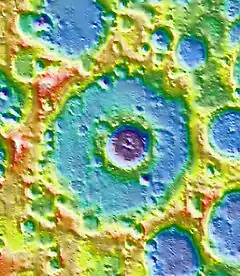Einstein (crater)
Einstein is a large lunar impact crater that lies along the western limb of the Moon, which makes it difficult to observe from the Earth. The visibility of this formation is subject to libration effects, but even under the best conditions not much detail can be observed except from lunar orbit. Nearby craters of note include Moseley just to the north, Dalton along the eastern rim, Vasco da Gama just to the southeast, and Bohr to the south-southeast. The formation Vallis Bohr is visible to the south.
 Lunar Orbiter 4 image. Einstein is the larger, eroded crater. The smaller central crater is Einstein A. | |
| Coordinates | 16.60°N 88.65°W |
|---|---|
| Diameter | 181 km |
| Depth | Unknown |
| Colongitude | 91° at sunrise |
| Eponym | Albert Einstein |

The outer rim of this walled plain has been strongly obliterated by many smaller impacts. Occupying the center of the interior floor is Einstein A, an impact crater with terraced inner walls and a central peak. The outer rampart of this concentric crater spreads across the interior floor, covering over half the diameter of Einstein. Several smaller craters also lie scattered across the floor, but there are sections of relatively flat surface in the southwest part of the floor. Two small craters on the west side have fissured floors. These are believed to be secondary craters from the Orientale impact to the south.[1]
The widespread notion that this crater was discovered by Patrick Moore in 1939[2][3][4] is probably erroneous.[5] In the middle of the 20th century Hugh Percy Wilkins designated the crater Caramuel to honor Juan Caramuel y Lobkowitz.[6][7] The crater was known under this unofficial name for some time,[4][8] but neither this name, nor almost all of Wilkins' other nomenclature, were adopted by the International Astronomical Union.[9] In 1963 E. Whitaker and D.W.G. Arthur named thie crater Einstein after Albert Einstein,[8] and in 1964 this name was adopted by the IAU.[10] Wilkins' map also contained a crater called Einstein, but it is a less prominent one[8] – Simpelius D.[2]
Satellite craters
By convention these features are identified on lunar maps by placing the letter on the side of the crater midpoint that is closest to Einstein.
| Einstein[10] | Coordinates | Diameter, km |
|---|---|---|
| A | 16.69°N 88.25°W | 50 |
| R | 13.83°N 91.88°W | 20 |
| S | 15.10°N 91.67°W | 20 |
See also
- 2001 Einstein, minor planet
References
- The geologic history of the Moon, 1987, Wilhelms, Don E.; with sections by McCauley, John F.; Trask, Newell J. USGS Professional Paper: 1348. Figure 3.9 A (online)
- Moore P.; Cattermole P. J. (1967). The Craters of the Moon. New York: W. W. Norton and Company Inc. pp. 124 (image on p.63).
- Allen D. A. (June 1966). "The Lunar Crater Caramuel". Journal of the British Astronomical Association. 76: 248–255. Bibcode:1966JBAA...76..248A.
- Allen D. A.; Andrews C. J. (May 1969). "The last word on Einstein Crater (Caramuel)". Journal of the British Astronomical Association. 79: 288–290. Bibcode:1969JBAA...79..288A.
- Mobberley M. (2013). It Came From Outer Space Wearing an RAF Blazer!: A Fan's Biography of Sir Patrick Moore. Springer Science & Business Media. pp. 15, 22–23, 102, 171, 581. doi:10.1007/978-3-319-00609-3. ISBN 978-3-319-00609-3.
- "Wilkins 300-inch Map Names (from Wilkins and Moore, 1961)". the-moon.wikispaces.com. Retrieved 2014-12-11.
- "Unofficial Names of Hugh Percy Wilkins (from Wilkins and Moore, 1961)". the-moon.wikispaces.com. Retrieved 2014-12-11.
- Longshaw N. (June 2014). P. Grego (ed.). "Einstein surprise" (PDF). The British Astronomical Association Lunar Section Circular. 51 (6): 10–12. Archived from the original (PDF) on December 14, 2014.
- Whitaker E. A. (2003). Mapping and Naming the Moon: A History of Lunar Cartography and Nomenclature. Cambridge University Press. pp. 230, 235. ISBN 9780521544146.
- "Einstein". Gazetteer of Planetary Nomenclature. International Astronomical Union (IAU) Working Group for Planetary System Nomenclature (WGPSN). 2010-10-18. Retrieved 2014-12-13.
Sources
- Longshaw N. (June 2014). P. Grego (ed.). "Einstein surprise" (PDF). The British Astronomical Association Lunar Section Circular. 51 (6): 10–12. Archived from the original (PDF) on December 14, 2014.
- Allen D. A.; Andrews C. J. (May 1969). "The last word on Einstein Crater (Caramuel)". Journal of the British Astronomical Association. 79: 288–290. Bibcode:1969JBAA...79..288A.
- Andersson, L. E.; Whitaker, E. A. (1982). NASA Catalogue of Lunar Nomenclature. NASA RP-1097.CS1 maint: ref=harv (link)
- Bussey, B.; Spudis, P. (2004). The Clementine Atlas of the Moon. New York: Cambridge University Press. ISBN 978-0-521-81528-4.CS1 maint: ref=harv (link)
- Cocks, Elijah E.; Cocks, Josiah C. (1995). Who's Who on the Moon: A Biographical Dictionary of Lunar Nomenclature. Tudor Publishers. ISBN 978-0-936389-27-1.CS1 maint: ref=harv (link)
- McDowell, Jonathan (July 15, 2007). "Lunar Nomenclature". Jonathan's Space Report. Retrieved 2007-10-24.CS1 maint: ref=harv (link)
- Menzel, D. H.; Minnaert, M.; Levin, B.; Dollfus, A.; Bell, B. (1971). "Report on Lunar Nomenclature by the Working Group of Commission 17 of the IAU". Space Science Reviews. 12 (2): 136–186. Bibcode:1971SSRv...12..136M. doi:10.1007/BF00171763.
- Moore, Patrick (2001). On the Moon. Sterling Publishing Co. ISBN 978-0-304-35469-6.CS1 maint: ref=harv (link)
- Price, Fred W. (1988). The Moon Observer's Handbook. Cambridge University Press. ISBN 978-0-521-33500-3.CS1 maint: ref=harv (link)
- Rükl, Antonín (1990). Atlas of the Moon. Kalmbach Books. ISBN 978-0-913135-17-4.CS1 maint: ref=harv (link)
- Webb, Rev. T. W. (1962). Celestial Objects for Common Telescopes (6th revised ed.). Dover. ISBN 978-0-486-20917-3.CS1 maint: ref=harv (link)
- Whitaker, Ewen A. (2003). Mapping and Naming the Moon. Cambridge University Press. ISBN 978-0-521-54414-6.CS1 maint: ref=harv (link)
- Wlasuk, Peter T. (2000). Observing the Moon. Springer. ISBN 978-1-85233-193-1.CS1 maint: ref=harv (link)
